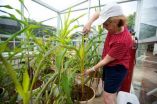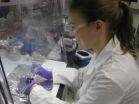(Press-News.org) PHILADELPHIA — The presence of chronic inflammation in benign prostate tissue was associated with high-grade, or aggressive, prostate cancer, and this association was found even in those with low prostate-specific antigen (PSA) levels, according to a study published in Cancer Epidemiology, Biomarkers & Prevention, a journal of the American Association for Cancer Research.
An analysis of prostate tissue biopsies collected from some participants of the placebo arm of the Prostate Cancer Prevention Trial (PCPT) found that those whose benign prostate tissue had chronic inflammation had 1.78 times higher odds of having prostate cancer, and 2.24 times higher odds of having an aggressive disease (characterized by Gleason sum of seven to 10), compared with those whose benign prostate tissue had no inflammation.
"We had the unique opportunity to investigate biopsy tissue from patients who had no indication to prompt a biopsy," said Elizabeth A. Platz, Sc.D., MPH, professor in the Department of Epidemiology at the Johns Hopkins Bloomberg School of Public Health in Baltimore, Md. "Participants in the PCPT who were not diagnosed with prostate cancer during the trial were recommended to undergo prostate biopsy at the end of that trial, which meant that prostate tissue was available not just for men who had the diagnosis of prostate cancer, but also for those who did not have the diagnosis.
"We found that men who had at least one biopsy core with inflammation had a higher likelihood of having high-grade prostate cancer compared with those who did not have any inflammation in their biopsy tissue," said Platz. "While we know that inflammation is common in prostate tissue from men who have some indication to prompt a biopsy, such as high PSA or an abnormal digital rectal examination [DRE], we were surprised to find that the prevalence of chronic inflammation in the men who didn't have any such indication was really high, about 78 percent."
Between 1993 and 1997, 18,882 men who were at least 55 years old and had a normal DRE with a serum PSA of 3 ng/ml or less, were recruited to the PCPT. All participants completed questionnaires that included demographics, lifestyle, and medical factors, and were followed for seven years after they were randomly assigned to receive either finasteride or placebo.
The investigators screened all participants for prostate cancer by PSA and DRE during annual visits. Those who had an indication underwent a "for-cause" biopsy if they had cancer, and those who did not have prostate cancer diagnosed during the trial were recommended to undergo an "end-of-study" biopsy at the end of the trial even if they did not have an indication.
From the placebo arm of this study, Platz and colleagues sampled 191 prostate cancer cases and 209 frequency-matched controls for whom biopsy tissue was available. They performed histopathological evaluation of the biopsy samples to identify the prevalence and extent of inflammation, and types of inflammation, i.e., acute or chronic inflammation.
They found that 86.2 percent of cases and 78.2 percent of controls had at least one biopsy core with inflammation, most of which was chronic, and this difference was statistically significant. They also found that the association between chronic inflammation and aggressive prostate cancer did not change after adjusting for known risk factors including body-mass index, pack-years of cigarettes smoked, and history of diabetes.
In addition, this association held true even among men whose PSA levels were less than 2 ng/mL. "We detected chronic inflammation in prostate tissue of men who had prostate cancer but had PSA levels lower than 2 ng/ml, and thus our work supports an association between inflammation and prostate cancer that is not explained by PSA-associated detection bias," said Platz.
Among men whose PSA levels were less than 2 ng/ml at the time of biopsy, those whose prostate tissue had inflammation had 4.11 times higher odds of having aggressive prostate cancer, compared with those whose prostate tissue did not have any inflammation.
"Our team is next studying the type of inflammatory cells that may be influencing the risk of aggressive prostate cancer," said Platz. "This study is a stellar example of multidisciplinary research involving epidemiologists, pathologists, immunologists, urologists, and biostatisticians," Platz added.
INFORMATION:
Angelo De Marzo, M.D., Ph.D., professor in the Department of Pathology at the Johns Hopkins Hospital, is a co-leader of this study.
This study and the PCPT, which was conducted by Southwest Oncology Group, were funded by the National Cancer Institute. Platz and De Marzo declare no conflicts of interest.
Follow the AACR on Twitter: @AACR
Follow the AACR on Facebook: http://www.facebook.com/aacr.org
About the American Association for Cancer Research
Founded in 1907, the American Association for Cancer Research (AACR) is the world's oldest and largest professional organization dedicated to advancing cancer research and its mission to prevent and cure cancer. AACR membership includes more than 34,000 laboratory, translational, and clinical researchers; population scientists; other health care professionals; and cancer advocates residing in more than 90 countries. The AACR marshals the full spectrum of expertise of the cancer community to accelerate progress in the prevention, biology, diagnosis, and treatment of cancer by annually convening more than 20 conferences and educational workshops, the largest of which is the AACR Annual Meeting with more than 18,000 attendees. In addition, the AACR publishes eight peer-reviewed scientific journals and a magazine for cancer survivors, patients, and their caregivers. The AACR funds meritorious research directly as well as in cooperation with numerous cancer organizations. As the Scientific Partner of Stand Up To Cancer, the AACR provides expert peer review, grants administration, and scientific oversight of team science and individual grants in cancer research that have the potential for near-term patient benefit. The AACR actively communicates with legislators and policymakers about the value of cancer research and related biomedical science in saving lives from cancer. For more information about the AACR, visit http://www.AACR.org.
Chronic inflammation may be linked to aggressive prostate cancer
2014-04-18
ELSE PRESS RELEASES FROM THIS DATE:
Chronic inflammation linked to 'high-grade' prostate cancer
2014-04-18
Men who show signs of chronic inflammation in non-cancerous prostate tissue may have nearly twice the risk of actually having prostate cancer than those with no inflammation, according to results of a new study led by researchers from the Johns Hopkins Kimmel Cancer Center.
The link between persistent inflammation and cancer was even stronger for men with so-called high-grade prostate cancer — those with a Gleason score between 7 and 10 — indicating the presence of the most aggressive and rapidly growing prostate cancers.
"What we've shown in this observational study ...
Study sheds light on how the immune system protects children from malaria
2014-04-18
According to a study published today in PLOS Pathogens, children who live in regions of the world where malaria is common can mount an immune response to infection with malaria parasites that may enable them to avoid repeated bouts of high fever and illness and partially control the growth of malaria parasites in their bloodstream. The findings may help researchers develop future interventions that prevent or mitigate the disease caused by the malaria parasite.
Each year, approximately 200 million cases of malaria occur worldwide, resulting in roughly 627,000 deaths (mostly ...
Better thermal-imaging lens from waste sulfur
2014-04-18
Sulfur left over from refining fossil fuels can be transformed into cheap, lightweight, plastic lenses for infrared devices, including night-vision goggles, a University of Arizona-led international team has found.
The team successfully took thermal images of a person through a piece of the new plastic. By contrast, taking a picture taken through the plastic often used for ordinary lenses does not show a person's body heat.
"We have for the first time a polymer material that can be used for quality thermal imaging – and that's a big deal," said senior co-author Jeffrey ...
JCI online ahead of print table of contents for April 17, 2014
2014-04-18
Double-stapled peptide inhibits RSV infection
Respiratory syncytial virus (RSV) is a leading cause of lower respiratory tract infections, generating life-threating illness in very young and elderly populations. Despite great effort, preventive therapies are limited. RSV enters host cells through the fusion protein RSV F, which forms a six-helix fusogenic bundle. Small interfering peptides that prevent bundle formation limit RSV infection in vitro; however, these peptides are highly susceptible to degradation. In this issue of the Journal of Clinical Investigation, Loren ...
Chickens to chili peppers
2014-04-18
Suddenly there was a word for chili peppers. Information about archaeological remains of ancient chili peppers in Mexico along with a study of the appearance of words for chili peppers in ancient dialects helped researchers to understand where jalapeños were domesticated and highlight the value of multi-proxy data analysis. Their results are from one (Kraig Kraft et al.) of nine papers presented in a special feature issue of the Proceedings of the National Academy of Sciences on plant and animal domestication edited by Dolores Piperno, staff scientist emerita at the Smithsonian ...
Novel marker discovered for stem cells derived from human umbilical cord blood
2014-04-17
New Rochelle, NY, April 17, 2014—The development of stem cell therapies to cure a variety of diseases depends on the ability to characterize stem cell populations based on cell surface markers. Researchers from the Finnish Red Cross have discovered a new marker that is highly expressed in a type of stem cells derived from human umbilical cord blood, which they describe in an article in BioResearch Open Access, a peer-reviewed journal from Mary Ann Liebert, Inc., publishers. The article is available free on the BioResearch Open Access website.
Heli Suila and colleagues, ...
Five anthropogenic factors that will radically alter northern forests in 50 years
2014-04-17
COLUMBIA, Mo. April 17 – In the most densely forested and most densely populated quadrant of the United States, forests reflect two centuries of human needs, values and practices. Disturbances associated with those needs, such as logging and clearing forests for agriculture and development, have set the stage for management issues of considerable concern today, a U.S. Forest Service study reports.
The report – Five anthropogenic factors that will radically alter forest conditions and management needs in the Northern United States – was published recently by the journal ...
CU researchers discover target for treating dengue fever
2014-04-17
AURORA, Colo. (April 17, 2014) – Two recent papers by a University of Colorado School of Medicine researcher and colleagues may help scientists develop treatments or vaccines for Dengue fever, West Nile virus, Yellow fever, Japanese encephalitis and other disease-causing flaviviruses.
Jeffrey S. Kieft, PhD, associate professor of biochemistry and molecular genetics at the School of Medicine and an early career scientist with the Howard Hughes Medical Institute, and colleagues recently published articles in the scholarly journals eLife and Science that explain how flaviviruses ...
Vitamin B3 might have been made in space, delivered to Earth by meteorites
2014-04-17
Ancient Earth might have had an extraterrestrial supply of vitamin B3 delivered by carbon-rich meteorites, according to a new analysis by NASA-funded researchers. The result supports a theory that the origin of life may have been assisted by a supply of key molecules created in space and brought to Earth by comet and meteor impacts.
"It is always difficult to put a value on the connection between meteorites and the origin of life; for example, earlier work has shown that vitamin B3 could have been produced non-biologically on ancient Earth, but it's possible that an added ...
Bright points in sun's atmosphere mark patterns deep in its interior
2014-04-17
Like a balloon bobbing along in the air while tied to a child's hand, a tracer has been found in the sun's atmosphere to help track the flow of material coursing underneath the sun's surface.
New research that uses data from NASA's Solar Dynamics Observatory, or SDO, to track bright points in the solar atmosphere and magnetic signatures on the sun's surface offers a way to probe the star's depths faster than ever before. The technique opens the door for near real-time mapping of the sun's roiling interior – movement that affects a wide range of events on the sun from ...






